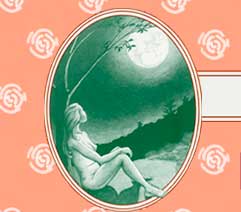My midwife recommended this book and it proved to be my favorite book during pregnancy. It was easy to read and offered advice in many issues of pregnancy and childbirth from fertility issues to infant problems. I was new to herbal medicine and found Weed's guidance easy to follow. This book, along with some raspberry leaf tea, would make a great gift for your pregnant friends.
EXCERPTS
HERBAL PHARMACY – Meeting the Plants
by Susun Weed
In your herbal pharmacy you transform fresh and dried plants into herbal medicines. Learning to identify and use the common plants around you is easy and exciting, beneficial and safe. Making your own medicines saves you money if you follow the Wise Woman tradition of using local herbs, free for the taking.
Even one day's work in field, forest, and kitchen can provide you with many years' worth of medicines. When you make your own, you know for sure what's in it, where it came from, when and how it was harvested, and how fresh and potent it is.
Dried herbs are best for the infusions recommended in this book. Stock your herbal pharmacy with your own foraged or cultivated dried herbs; expand your resources and experiment with new herbs by buying dried herbs from reputable sources.
Fresh herbs are best for the tinctures and oils recommended in this book. If you can't make your own, buy from sources who wildcraft or grow their own herbs to use fresh in preparations.
Whether you buy or make your own medicines, remember, herbal remedies may not work or may work incorrectly if they aren't prepared correctly. Read this chapter carefully; it contains easy to follow instructions for every remedy and preparation mentioned in this book [Wise Woman Herbal for the Childbearing Year].
Meeting the Plants
Start by noticing the plants that live with you, along your driveway or sidewalk. Don't assume that medicinal plants are hard to find. Fennel, Pepper Grass, Dandelion, Plantain, and Mugwort (to name a few) are as common in cities and suburbs as in the country.
Learn more about the weeds around you directly from the plants, from a personal guide, and from field guides and herbals.
When we open all our senses, including the psychic ones, to the green world, we learn to hear and understand plant language. Through shape, color, location, scent, texture, taste, and energy, plants tell us how they will affect our bodies, which plant parts we can use, and how we prepare them.
Some Wise Women converse with the plant fairies and the devas. Some hear the song that each plant sings. Some feel the dances of the leaves, breezes, and insects. All are means of learning the ways of herbs. Though the scientific tradition scoffs at such knowledge, the Wise Woman tradition honors the plant as the ultimate authority on its uses.
A personal guide into the plant world will show you plant features which ensure positive identification, such as the hairs on Wild Carrot which safely distinguish it from Poison Hemlock. A personal guide will introduce you to the foods, medicines, dyes, fibers, decorations, and delights hidden in common plants, and instruct you in wise harvesting and preparation. Check local garden clubs, botanical gardens, and nature centers for contacts with personal guides.
Field guides are indispensable references once your taste for herbal identification is whetted. I find the line drawings in the Petersen guides more helpful than color photographs when I have to distinguish between similar looking plants.
Herbals concentrate on the specifics of using plants as medicines and are rarely illustrated well enough to serve as a guide to identification. Field guides hardly ever include information on medicinal value. The link between your field guide and your herbal is the botanical binomial, or Latin name, of each plant.
The binomial is (usually) consistent in all references, unlike common names which overlap and vary from region to region. Once you have identified a new plant, you can look it up by finding the binomial in herbals and other references. This can increase your confidence and ability to find and use safe herbal medicines.
My years of leading Weed Walks and helping people identify wild plants have shown me that learning to recognize herbs in the field is far easier, and much less fraught with danger, than most people realize. As Euell Gibbons is quoted as saying: "You don't learn all the plants at once; you learn them one at a time."
Even if you never pick your own herbs, knowing how the live plants look will be a great asset when you go out to buy them.
Green Blessings.
Susun Weed


